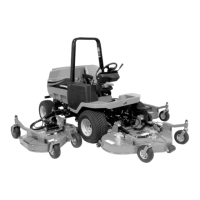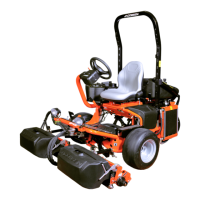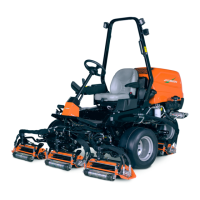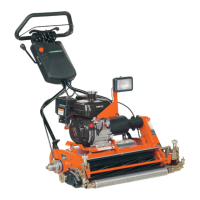6-18 4203780 First Edition
HYDRAULICS
6
Mower Deck Float Circuit Schematic
and Theory of Operation
System Conditions:
• Engine running
• Right, left, and/or front cutting units lowered to the
ground
• Right, left, and/or front cutting units lift/lower lever(s)
in NEUTRAL position
Oil Supply to Lift Valves
Hydraulic oil is drawn from the hydraulic oil tank by
section 1 of the gear pump assembly. Before entering the
gear pump assembly, the inlet oil is filtered by a
100-mesh screen to remove any debris.
Operating-pressure oil from section 1 of the gear pump is
routed to port “P” of the control valve and flows through
the 4.5-gpm priority valve. The four-section gear pump
will need to produce a flow rate of 4.5 gpm before the
priority valve opens to supply oil to the lift valve.
The priority valve will supply oil flow to the steering valve
before allowing oil flow to the lift valve, to ensure
maximum steering control at any engine rpm range.
Float Circuit
With the cutting units lowered, and the lift/lower levers in
the NEUTRAL position, oil from the lift cylinders can flow
freely in both directions through the detent and spool
valves.
As the cutting units move along the ground, they rise and
fall with the contour of the ground. As cutting units rise,
oil from the piston end of the cylinders flows back into the
lift valve block. As the cutting units drop to follow the
ground contour, oil flows back into the lift cylinder. As the
cutting units drop, operating-pressure oil flows through
the valves to supply make-up oil to the piston end of the
lift cylinders. Operating-pressure oil flows to the weight
transfer valve, opening the valve and allowing the excess
oil to dump to the hydraulic tank.
Slight upward pressure (up to 50 psi) is maintained
against the lift cylinders. This is accomplished with an
adjustable weight transfer valve located in the hydraulic
return line between the lift valve body and the hydraulic
tank. This valve can be adjusted to increase or decrease
the amount of cutting unit weight being transferred to the
ground, thus increasing or decreasing weight transfer to
the machine’s drive wheels.
This allows the machine to retain traction while allowing
the cutting units to adapt to variations in ground contour.

